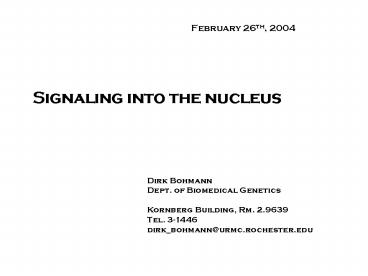Dirk Bohmann PowerPoint PPT Presentation
1 / 26
Title: Dirk Bohmann
1
February 26th, 2004
Signaling into the nucleus
Dirk Bohmann Dept. of Biomedical
Genetics Kornberg Building, Rm. 2.9639 Tel.
3-1446 dirk_bohmann_at_urmc.rochester.edu
2
Many, but not all, cellular signal responses
involve changes in the gene expression program of
the cell.
This means that an appropriate subset of genes in
the genome of the responding cell is either
turned on or off.
This requires gene selective and
signal-responsive mechanisms acting at the level
of transcription, RNA processing and stability,
translation, or at the protein level.
A major point at which the activity of genes is
regulated is (the initiation of) transcription.
3
Structure of a eukaryotic RNA pol. II-transcribed
gene
4
Transcription activators and basal machinery
5
Co-Activators Mediate Transcription Activation
6
A Multiplicity of Co-Regulators
7
Signal Responsiveness
Regulation at the level of synthesis
Signal
8
Signal Responsiveness
Regulation at the protein level
Immediate early genes are activated by protein
synthesis-independent mechanisms
Signal
?
immediate early mRNA
9
Regulation of transcription factor activity at
the protein level
- post-translational Modification
Phosphorylation Ubiquitylation - Acetylation
- (Redox)
- Protein-protein interactions
- Protein-ligand interactions
10
Transcription Factor Activity can be Regulated in
Many Different Ways
11
Un-liganded Lac Repressor binds to the Operator
site and precludes access of Polymerase to the
promoter.
12
Lactose binds to Lac repressor and causes
an allosteric change that prevents DNA binding.
Polymerase can bind, transcription ensues.
13
Ligands for nuclearhormone receptors
14
Activation of Steroid Hormone Receptors
15
Retinoic acid receptor represses Transcription in
the absence of ligand
and activates it in the ligand bound form.
This involves a switch from histone
deacetylation to histone acetylation.
16
NF-kB Signaling
Cytokines such as TNF or IL-1 engage their
receptors.
NIK kinase is activated and turns on IKKa b
The IKKs phosphorylate I-kB, the inhibitor of
NF-kB on two serine residues.
Phosphorylated I-kB is multi- ubiquitylated and
degraded in the proteasome.
NF-kB (e.g. a p50/p65 hetero- dimer) is released
and its NLS is exposed.
NF-kB moves to the nucleus and activates target
gene transcription.
17
Wnt-TCF signaling
Wnt binds to Frizzled receptor which activates
the adaptor protein Deshevelled (Dsh) by an
unknown mechanism.
Dsh inhibits Glycogen Synthase Kinase-3 (GSK-3),
which would otherwise phosphorylate b-catenin
and target it for degradation.
Stabilized b-catenin can move to the nucleus and
associate with the DNA-binding protein TCF to
stimulate target gene transcription.
18
(No Transcript)
19
Cytoplasm
Nucleus
Activation by the JNK Pathway
20
MEKK
Cytoplasm
JNKK
JNK
Nucleus
21
RTK
GRB2
SOS
Ras
Cytoplasm
RAF
MEK
ERK
Nucleus
JNK
c-fos
Jun
Fos
22
c-Jun is required for Ras transformation in a
cell culture model
Johnson R, Spiegelman B, Hanahan D, Wisdom R Mol
Cell Biol. 1996 16(8)4504-11 Cellular
transformation and malignancy induced by ras
require c-jun.
23
and for chemically induced liver cancer in mice
Eferl R, Ricci R, Kenner L, Zenz R, David JP,
Rath M, Wagner EF. Cell. 2003 112(2)181-92.
Liver tumor development. c-Jun antagonizes the
proapoptotic activity of p53.
24
A knock in mutation that removes MAPK sites in
c-Jun reduces cell transformation
Fos
Jun
Behrens A, Jochum W, Sibilia M, Wagner EF.
Oncogene. 2000 19(22)2657-63. Oncogenic
transformation by ras and fos is mediated by
c-Jun N-terminal phosphorylation.
25
Signal dependent Transcription Factors Examples
26
Required Reading
- Eferl, R., Ricci, R., Kenner, L., Zenz, R.,
David, J. P., Rath, M., and Wagner, E. F. (2003).
Liver tumor development. c-Jun antagonizes the
proapoptotic activity of p53. Cell 112, 181-192. - Johnson, R., Spiegelman, B., Hanahan, D., and
Wisdom, R. (1996). Cellular transformation and
malignancy induced by ras require c-jun. Mol Cell
Biol 16, 4504-4511. - Maeda, S., and Karin, M. (2003). Oncogene at
last--c-Jun promotes liver cancer in mice. Cancer
Cell 3, 102-104. - Wisdom, R. (1999). AP-1 one switch for many
signals. Exp Cell Res 253, 180-185.
Relevant Reviews

